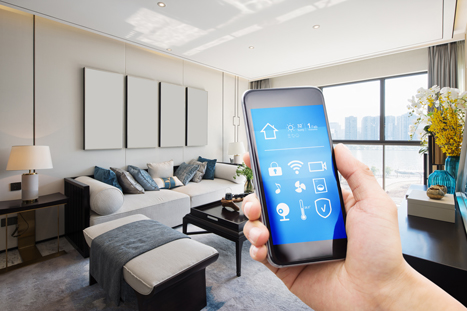What is Automatic Zoning?
Posted on by WestAIR Heating & Cooling
 Artificial Intelligence. Self-Driving cars. Virtual Assistants. Every day, advancements in technology amaze and inspire us to automate and simplify our lives. So, what’s stopping you from getting smart with your HVAC system?
Artificial Intelligence. Self-Driving cars. Virtual Assistants. Every day, advancements in technology amaze and inspire us to automate and simplify our lives. So, what’s stopping you from getting smart with your HVAC system?
Home Automation
Automatic zoning or smart zoning, a category of smart home technology, allows you to control the temperature of each living space or zone in your home. Your bedroom or living room are primary zones that most people like to set to different temperatures. The issue? Older thermostats read the temperature in the middle of the home. Basements end up feeling cooler while second story rooms become warmer. Automatic zoning uses motorized dampers inside your ductwork that control the airflow to each zone. Select a zone and set a comfortable temperature using your smartphone or other device. The control panel in your HVAC system receives the information from your thermostat to adjust the dampers and temperature to your desired settings. It’s that simple!
New Technology
Zoning your HVAC system is not necessarily new technology but monitoring your setting from a device is. In the past, homeowners installed multiple thermostats or HVAC units to control these systems. Now you can regulate the temperature through one system in one location without ever touching a thermostat. If a room is not in use, automatic zoning reroutes the air to save energy. You can control all these settings with your phone, online, or right on the thermostat. Manufacturers create smart thermostats to sync with your Wi-Fi and easily customize to your lifestyle. Adjust your home’s temperature from anywhere!
Add-on Features
When you install automatic zoning, you can add more features to your heating and cooling system, too.
Fresh Air Intake
Bring fresh air into your home while using your heating or cooling unit.
Air Cleaner
Install an air cleaner to remove pollutants such as dust, pollen, and contaminants throughout the home.
Humidifier
Add a humidifier to make cold seasons more comfortable while preserving your home. Dry air cracks and warps the woodwork and building materials.
WestAIR can create a comfortable atmosphere for any room in your home. Save on energy bills by installing energy efficient automatic zoning. Contact us today to learn more.
This entry was posted in AC,Air Conditioning,Cooling,Furnace,Heating,Indoor Air Quality and tagged Air cleaner, Automatic zoning, Basement, Bedroom, Damper, Ductwork, Energy efficiency, Fresh air intake, Heating and cooling, Home automation, Humidifier, HVAC zoning, Living room, Smart home, Smart thermostat, Smart zoning, Thermostat
How to Improve Indoor Air Quality
Posted on by WestAIR Heating & Cooling
 In some cities, air pollution and smog create major health concerns. But the air inside of your home could contain more contaminates no matter where you live. Changing your living habits and investing in superior equipment will make major improvements to your indoor air quality.
In some cities, air pollution and smog create major health concerns. But the air inside of your home could contain more contaminates no matter where you live. Changing your living habits and investing in superior equipment will make major improvements to your indoor air quality.
Cleaning
If your home contains carpet, use a high-quality vacuum with a HEPA filter to reduce household dust, pet dander, and chemicals. Experts recommend vacuuming at least two times a week. For homes without carpet, sweeping and mopping effectively captures dirt and pollutants. Dry microfiber mops successfully grab dust and allergens as well but don’t require any chemical cleaners. Putting extra care into your cleaning routine will not only improve the look of your home but also the air quality. Think of all the chemicals, fecal matter, and allergens that cling to your shoes or clothing when you enter a building. Taking your shoes off or using a large matt to wipe your shoes can help reduce pollutants as well.
Reducing Toxicity
One of the worst culprits of compromised indoor air quality is cigarette smoke. The smoke contains more than 4,000 chemicals and can increase the risk of asthma, lung cancer, and stroke. Radon poses as another risk for lung cancer, especially in the Midwest where the gas concentrations are high. Radon gas comes from the natural decay of uranium in the ground and leaks through your home’s foundation. Call a professional if your house has not been tested for radon. Toxic particles can come from the products you use to clean, too. Fragrance and household chemicals emit VOCs (Volatile Organic Compounds). You can find VOCs in higher concentrations indoors, and they come with serious health risks. Reduce these chemicals by switching to natural or mild soaps or cleaners. Essential oils, vinegar, and baking soda can become effective DYI cleaners, too.
Air Support
Adding plants like dracaena, peace lilies, and spider plants improve indoor air quality and attractiveness inside your home. Air purifiers or air cleaners are even more effective at creating fresh and clean air. An air cleaner can capture 98% of airborne particles circulating through your home. We recommend these heating and cooling add-ons for people with asthma, allergies, or chronic illnesses. Depending on the MERV or HEPA rating, filters capture dust, pollen, mold, pet dander, pollutants, viruses and bacteria in the air. Dust mites and mold also thrive in moisture, so investing in an air exchanger or dehumidifier to use in the summer months will help as well. If your house smells musty or already shows signs of mold, you should invest in a dehumidifier.
Would you like better indoor air quality?
Contact WestAIR Heating and Cooling for more information on dehumidifiers and air cleaners.
This entry was posted in Indoor Air Quality and tagged Air cleaner, Air purifier, Allergies, Asthma, Bacteria, Breathe better, Cancer, Chemicals, Cigarettes, Clean air, Cleaning, Dehumidifier, Dust, Fragrance, HEPA, Home purifier, MERV, Mold, Natural alternatives, Pet dangers, Plants, Radon, Smoking, Toxic, Vacuum, Viruses, VOCs
Subscribe to Our Blog
With RSS feeds, you don't have to visit our site everyday to keep up to date. Simply subscribe to our blog via RSS or Email and our posts will come to you!
Search Blog Posts
Categories
Archives
- April 2024 (1)
- February 2024 (1)
- January 2024 (1)
- February 2023 (1)
- January 2023 (1)
- December 2022 (1)
- November 2022 (1)
- October 2022 (1)
- September 2022 (1)
- August 2022 (1)
- July 2022 (1)
- June 2022 (1)
- May 2022 (1)
- April 2022 (1)
- March 2022 (1)
- February 2022 (2)
- December 2021 (1)
- November 2021 (1)
- October 2021 (1)
- September 2021 (1)
- August 2021 (1)
- July 2021 (1)
- June 2021 (1)
- May 2021 (1)
- April 2021 (1)
- March 2021 (2)
- January 2021 (1)
- December 2020 (1)
- November 2020 (1)
- October 2020 (1)
- September 2020 (1)
- August 2020 (1)
- July 2020 (1)
- June 2020 (1)
- May 2020 (1)
- April 2020 (1)
- March 2020 (1)
- February 2020 (2)
- November 2019 (1)
- August 2019 (2)
- June 2019 (1)
- May 2019 (1)
- April 2019 (1)
- March 2019 (1)
- February 2019 (1)
- January 2019 (1)
- December 2018 (1)
- November 2018 (1)
- October 2018 (1)
- September 2018 (1)
- August 2018 (2)
- July 2018 (1)
- May 2018 (1)
- April 2018 (1)
- March 2018 (1)
- February 2018 (1)
- January 2018 (1)
- December 2017 (3)
- November 2017 (2)
- October 2017 (2)
- September 2017 (2)
- August 2017 (1)
- July 2017 (2)
- June 2017 (3)
- May 2017 (2)
- January 2017 (4)
- November 2016 (1)
- September 2016 (3)
- July 2016 (2)
- June 2016 (2)
- May 2016 (4)
- April 2016 (1)
- March 2016 (2)
- February 2016 (2)
- January 2016 (1)
- August 2015 (1)
- July 2015 (1)
- June 2015 (3)
- May 2015 (1)
- July 2014 (2)
- June 2014 (1)
- April 2014 (1)
- March 2014 (1)
- February 2014 (2)
- October 2013 (1)
- May 2013 (1)
- March 2013 (1)
- February 2013 (1)
- August 2012 (1)
- July 2012 (2)
- June 2012 (2)
- May 2012 (2)
- March 2012 (1)
- February 2012 (1)
- December 2011 (1)
- November 2011 (1)
- October 2011 (1)
- September 2011 (1)
- August 2011 (1)
- June 2011 (1)
- May 2011 (1)
 Subscribe
Subscribe Subscribe
Subscribe